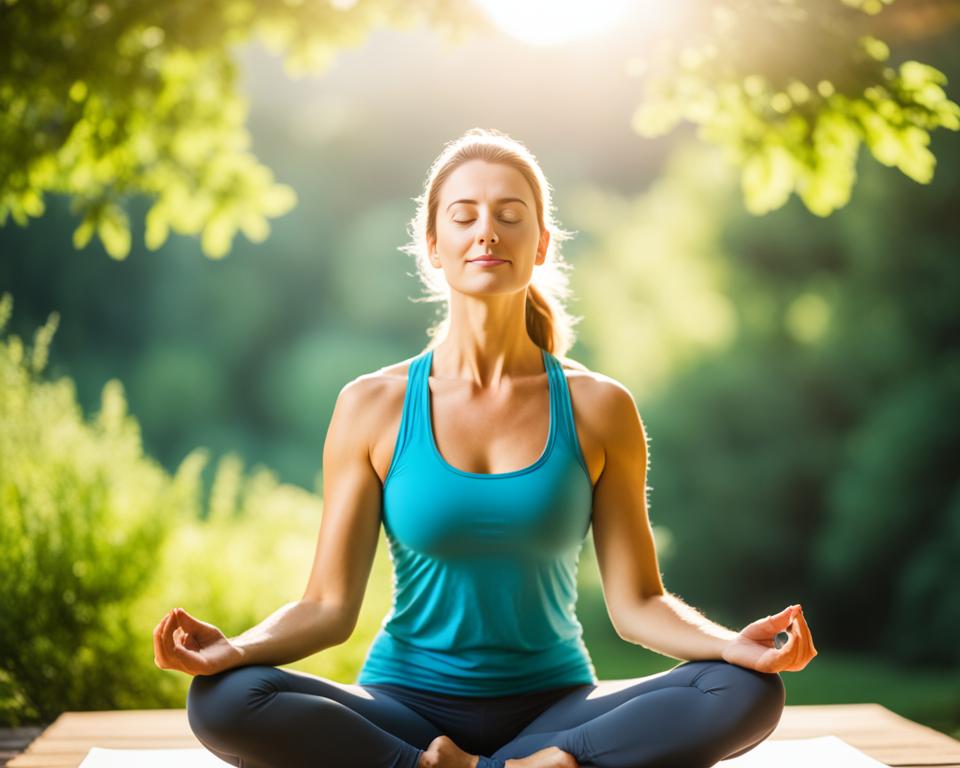Many wonder how long it takes to become a yoga instructor. The time needed varies based on the certification level and program choice. For basic certification, a 200-hour training program is the minimum requirement.
This article aims to shed light on becoming a yoga instructor. It explores the time and steps for different certification levels. Whether you are looking at a 200-hour program or aiming for 800 hours to be a yoga therapist, we cover the necessary commitments.
Key Takeaways:
- The duration of yoga teacher training varies based on the level of certification and program chosen.
- Basic certification requires a minimum of 200 hours of training.
- Specialized certifications, such as yoga therapy, may require 800 hours of training.
- Hands-on experience and continuing education are essential for growth as a yoga instructor.
- Accreditation from organizations like the Yoga Alliance ensures the quality of training programs.
The Path to Yoga Instruction
Before you start your yoga instructor journey, you need to know the different certifications available. You can go from basic 200-hour courses to specialized training, like yoga therapy. The duration of training to be a yoga instructor can vary depending on the program you choose. A typical 200-hour yoga teacher training can take around three to six months to complete. However, some programs offer intensive training that can be completed in as little as four weeks.
If you’re looking for a more in-depth understanding of yoga and want to specialize in a particular area, you may consider advanced training programs. These programs can range from 300 to 500 hours and can take several months to a year to complete.
An Overview of Yoga Teaching Certifications
Yoga certifications help you teach and guide others in yoga. The length and depth of these certifications vary, so you can find what fits your goals.
To begin teaching, many start with a 200-hour course. This covers fundamental yoga teaching like poses, breathing, meditation, and how to teach.
Later, you can take advanced courses to learn more, like harder poses and teaching techniques. These also focus on the deeper philosophical aspects of yoga.
There are also courses that can make you an expert in a specific area, as with yoga therapy for healing through yoga.
Diving into the 200-Hour Yoga Teacher Training
The first step for those dreaming of teaching yoga is a 200-hour course. This includes learning the basics of yoga as well as how to teach it.
This course teaches you essential yoga poses and how to properly execute and teach them. You’ll also learn about breathing exercises and incorporating meditation.
By the end, you’ll have everything you need to confidently start teaching yoga classes.
The Journey Beyond: Advanced Yoga Certifications
For advanced teachers, there are more certifications to explore. These go deeper into teaching, advanced poses, philosophy, and personal growth in yoga.
After the 200-hour course, you can specialize in different yoga styles. This could include Yin, restorative, or prenatal yoga.
Such advanced certifications make you a better teacher, ready to lead a wider range of classes and events.
So, whether you’re starting or advancing in your yoga instructor journey, there are many ways to learn and specialize in yoga.
Exploring Different Levels of Yoga Teacher Training
As an aspiring yoga instructor, you have different certification options. Each level helps you understand yoga better and teach more effectively. Let’s dive into what each level of training offers:
Getting Your Feet Wet: The 200-Hour Certification
The 200-hour certification is a common place to start. It teaches you basic yoga principles, how to teach, and the body’s anatomy. You’ll learn key poses, breathing exercises, and how to lead a safe class. This course often takes several months to complete.
Deepening Your Practice: 300-Hour Certification and Beyond
For a higher skill level, consider the 300-hour certification and above. Programs at this level delve into yoga philosophy, advanced poses, and more. They are open to those with a 200-hour certification. These advanced courses could last from several months to over a year.
Becoming a Yoga Therapist with 800 Hours of Training
If you’re into yoga for healing, yoga therapy might be your calling. You’ll need at least 800 hours of training. This teaches you how to use yoga for health and balance. After this, you can work with people with various health issues using yoga.
Every certification level helps you grow personally and professionally. Pick the one that best matches your yoga-teaching dreams. Each type of yoga teacher training has something special to offer.
How Long Does It Take to Become a Yoga Instructor
Becoming a yoga instructor can take different amounts of time based on the program. You’ll need to think about how much time you can give to this goal. Some courses are quick, taking only a few weeks to finish. Others will take a lot longer, maybe many months or even a year to complete.
In this section, we will look at how long most yoga teacher training programs last. We’ll also talk about what affects the time needed to certify as a yoga instructor.
The Importance of Hands-On Experience in Yoga Instruction
Taking a yoga teacher training program is key. Yet, getting hands-on experience is just as vital. It helps you build confidence and sharpens your teaching abilities by putting theory into practice. The duration of yoga instructor training varies, but most programs offer a comprehensive curriculum that covers various aspects of yoga, including philosophy, anatomy, and teaching methodologies. While the theoretical knowledge gained during these programs is undoubtedly valuable, it is through hands-on experience that aspiring instructors truly hone their skills.
Building Confidence through Teaching Practicums
Teaching practicums are often part of training. You lead real classes under the watch of pros. This lets you put your learning into action and get real feedback.
Leading a class during practicums helps a lot. You get to adjust your teaching style based on feedback. This boosts your confidence and helps you better understand how to lead a yoga class.
Watching experienced instructors during these sessions is also educational. You learn tips on teaching, managing a class, and connecting with students. This kind of learning is priceless for your teaching journey.
Finding Opportunities for Live Class Instruction
Besides practicums, looking for teaching chances outside your program is wise. This might mean teaching at studios, centers, or even for friends. Such experiences will polish your skills and understanding of student needs.
Real-life teaching also offers valuable feedback from students – an essential part of improvement. It helps you shape a teaching style that really reaches your students. This aspect makes your teaching more fulfilling and dynamic.
Actively looking for teaching practicums and live instruction not just improves your teaching. It also deepens your yoga practice. By embracing these opportunities, you pave the way to becoming a confident and exceptional yoga teacher.
Evaluating the Costs of Yoga Teacher Training
Starting a career as a yoga teacher brings joy. Yet, it’s wise to think about the money side. The fees for training can change a lot based on the certification you want and where you study.
Investing in Your Future: Typical Costs for Various Programs
Studying the price of yoga teacher training shows us the usual costs. The fees can differ, starting at a few hundred for short courses. They can climb into the thousands for longer, detailed training.
You also need to account for other expenses. This includes materials, books, and tools for your lessons. Thinking of these extra costs helps you understand the full money commitment needed for training.

Understanding the Financial Commitment: Tuition Fees and Other Expenses
Don’t just look at tuition costs. Add up other money needed for yoga training, like travel and where you’ll live. This is especially important if the program is far from your home.
It’s key to study the costs well before joining training. Planning your budget will let you enjoy learning without worrying about money.
The Significance of Accreditation and Certification Bodies
Accreditation and certification groups help keep yoga teacher training top-notch. They make sure teachers know how to teach yoga well and safely. The Yoga Alliance is a well-known group for yoga in the United States.
The Yoga Alliance sets the bar for what a yoga teacher training program should be. They check things like the class content if the teachers are qualified, and how many hours of teaching are done. This means students get a full education in yoga basics, such as poses, breathing, body structure, how to teach, and the ideas behind yoga.
Picking a yoga teacher who’s been through an accredited program means you’re choosing someone with solid training. Accreditation shows they’ve met tough standards and are ready to be great yoga guides.
Going for a program and a teacher that are accredited means you know the teaching is excellent. This really matters if you want to teach yoga yourself one day. Or if you’re looking to focus on helping people through yoga, meditation, or something like that.
When you look into a yoga program, check out which group says it’s good. Make sure that the association behind it is respected in the yoga world. This will guide you to a choice that fits your dreams of being a yoga teacher.
Continuing Education and Specialization Opportunities
Your journey as a yoga instructor goes beyond getting certified. You can keep learning and growing. Continuing education helps you know more and teach better. It makes the classes you offer even more valuable to your students.
Advanced Yoga Studies: Expanding Your Knowledge Base
Advanced studies in yoga dive deep into philosophy, sequencing, and anatomy. These courses give you lots of knowledge and ways to apply it. You get better at teaching and learn a lot more about yoga.
If you’re ready to learn more, think about joining advanced studies programs. They’re perfect for those already experienced. You’ll take your teaching to the next level with these advanced skills.
Specializations: Kids Yoga, Meditation, and Other Niches
Some people love to teach kids, while others prefer meditation. There are also other areas you can specialize in, based on what excites you. These specializations give you focused training. They help you better understand and meet specific group needs.
Getting certified in a special area opens up new teaching doors. You might want to work with kids, help people meditate, or something else. The right certification will help you do just that.
Yoga Teaching as a Career: Job Opportunities and Growth
Teaching yoga is a rewarding career that lets you share your love for yoga. The job market for yoga instructors is expanding, thanks to more people embracing yoga. You could find yourself teaching at studios, gyms, or through private sessions and retreats with the right training.
Prospects in the Yoga Industry
The demand for yoga instructors is on the rise, given yoga’s broad physical and mental health benefits. Studios, gyms, and other places that offer yoga are looking for more certified teachers to meet the growing demand for classes and workshops. This trend is expected to continue.
Yoga instructors can also join forces with various organizations, like resorts and schools, to introduce yoga to new groups. This could mean teaching yoga to kids, older adults, or those with special needs, offering unique career paths.
Building a Strong Personal Brand as a Yoga Instructor
In a competitive field, a unique personal brand is key. It highlights your style and what you offer. Developing a niche in the yoga world makes you more attractive to certain groups of people.
To stand out, use social media, websites, and networking to share your expertise. Engaging with students online and in person helps build a loyal following. Feeling part of a community with you at the center can set you apart.
It’s also vital to keep learning and stay updated in the field. More certifications, workshops, and learning from mentors can boost your skills. Lifelong learning makes you an even more valuable teacher in the eyes of your students.
Navigating Self-Study vs. Studio Learning in Yoga Training
You can choose between self-study or a studio to learn yoga. Both have their own benefits, letting you choose what fits your needs. This makes your training experience unique.
Self-study means you can learn yoga on your own time. You’re free to practice when it suits you best. You can use online tutorials, books, and videos to learn. This lets you focus on the parts of yoga that interest you most.

Studying in a studio gives you live help and support from others. You get to work closely with skilled teachers for personal tips and guidance. They can correct your moves right away to keep you safe and on track. Plus, you meet others who like yoga, making you feel part of a group.
So, which method suits you best? It depends on how you like to learn. If you prefer a set plan and learning with others, a studio might be your top pick. But if being your own boss and learning at your own pace is what you like, self-study wins out.
Knowing the good parts of self-study and studio learning helps you choose well. No matter which you pick, being consistent and dedicated is key. Both ways will help you grow and change through yoga.
To be a certified yoga instructor, complete a training program. Get some experience and keep learning. The training time varies, and it’s important to choose the right program for you.
Choosing this path will lead to a joyful career. You’ll help others find the wonders of yoga. You might start with basic poses or study advanced yoga types. The yoga world offers many chances to grow.
After getting certified, keep learning and improving. This will make you a better and more unique teacher. It’s important to market yourself well in the crowded yoga field.
Taking up this challenge can change more than your career. You’ll also grow in your own journey. Yoga can be a way to spread positivity and improve lives.
FAQs about Time Take to Become Yoga Teacher
How long does it take to become a yoga instructor?
Becoming a yoga instructor varies. It depends on the program and certification level you choose. Some programs are quick, while others take more time.
What are the different levels of yoga teaching certifications?
You can get certified at different levels. It starts with 200 hours. Then, you can go for advanced or specialized training like yoga therapy.
What is involved in a 200-hour yoga teacher training?
The 200-hour training gives you a strong start in yoga. It covers basics, teaching techniques, and body knowledge.
How can I advance my yoga teaching skills beyond the 200-hour certification?
After 200 hours, you can do more. There’s 300-hour training and then some. These can greatly increase your yoga knowledge.
How do I become a yoga therapist?
To be a yoga therapist, you need specialized training. This usually means 800 hours of practice and study.
How long does it take to complete a yoga teacher training program?
The time for training varies. It can be a few weeks for intensive courses. Or, it could be months or more for longer programs.
Why is hands-on experience important for yoga instructors?
Direct practice helps instructors a lot. It boosts their confidence and people skills. It also deepens their teaching through real interaction.
How can I gain teaching experience in yoga?
Training includes practice teaching. You can also teach at studios or in private. This helps in getting real teaching experience.
What are the job prospects for yoga instructors?
Yoga instructors have many places to work. They can teach in studios, gyms, or offer private sessions. Leading retreats is also an option.

